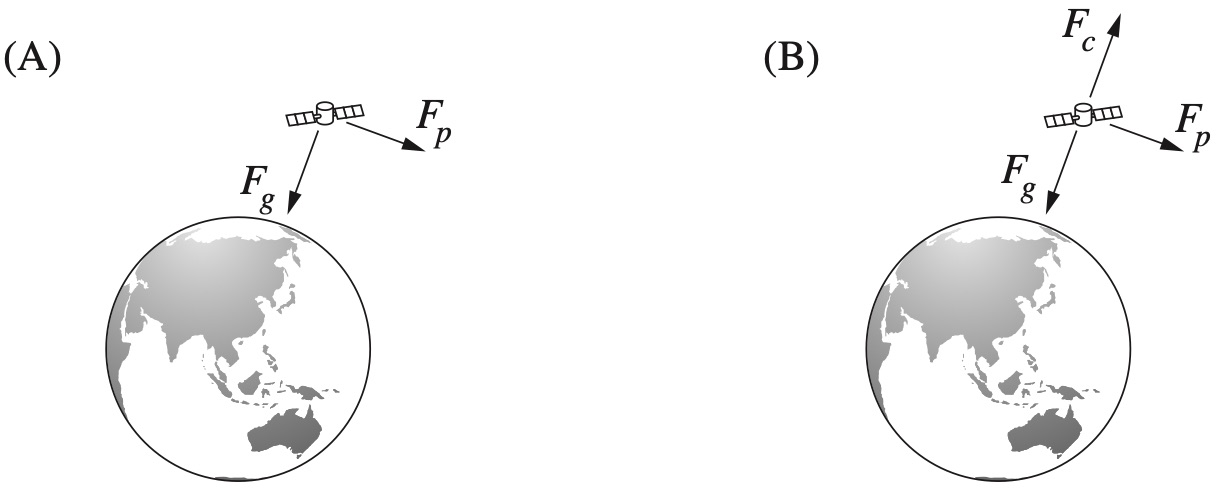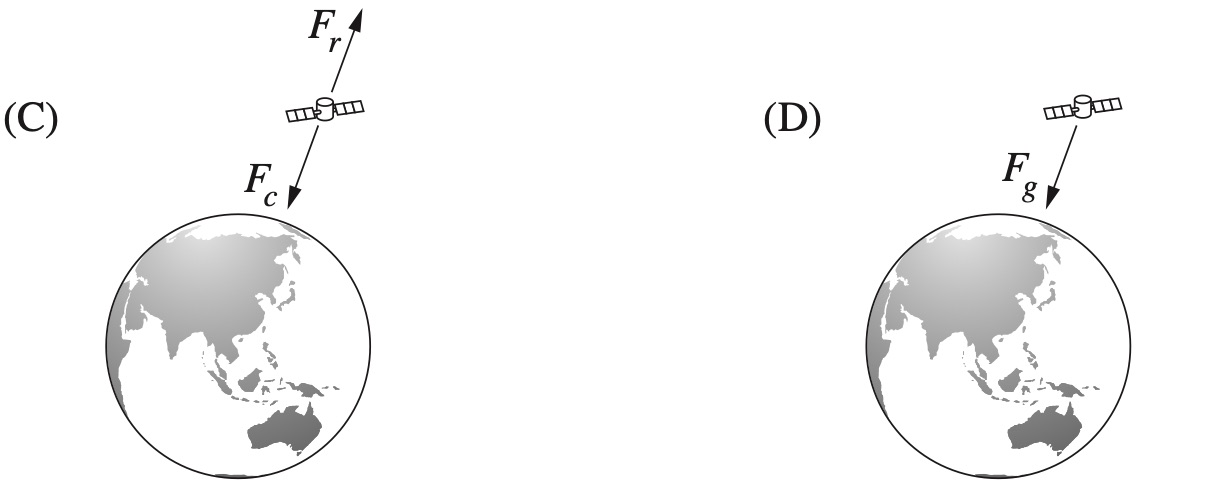A satellite with velocity \(v\), is in a geostationary orbit as shown in Figure 1.
At point \(Y\), the satellite explodes and splits into two pieces \(m_{ a }\) and \(m_{ b }\), of identical mass. As a result of the explosion, the velocity of one piece, \(m_{ a }\), changes from \(v\) to \(2 v\) as shown in Figure 2.
Analyse the subsequent motion of BOTH \(m_{ a }\) and \(m_{ b }\) after the explosion. Include reference to relevant conservation laws and formulae in your answer. (8 marks)
--- 22 WORK AREA LINES (style=lined) ---
Show Answers Only
At the point in time of the explosion:
- By the law of conservation of momentum, the momentum changes of \(m_a\) and \(m_b\) caused by the explosion must be equal in magnitude but opposite in direction.
- Since their masses are equal, both pieces experience the same change in velocity, but in opposite directions.
- Because the velocity of \(m_a\) increases by \(v\) in the direction it was already travelling, the velocity of \(m_b\) must also change by \(v\) but in the opposite direction to its original motion.
- Hence, relative to Earth, the velocity of \(m_b\) becomes zero at that instant.
Motion after the explosion:
- The satellite’s orbital velocity before the explosion is \(v_{\text{orb}}=\sqrt{\dfrac{GM}{r}}\) and the instantaneous velocity of \(m_a\) becomes twice this value.
- Since \(2v_{\text{orb}} = 2 \times \sqrt{\dfrac{GM}{r}} >\sqrt{\dfrac{2GM}{r}} \left(v_{\text{esc}}\right)\), the speed of \(m_a\) after the explosion exceeds escape velocity.
- After the explosion, \(m_a\) continues moving away from Earth with a decreasing speed, but because its initial speed is greater than escape velocity from that point, it will never return. Its total mechanical energy (kinetic + potential) remains constant and positive.
- Meanwhile, \(m_b\) begins accelerating from an initial velocity of zero toward Earth’s centre. Its initial acceleration is less than \(\text{ 9.8 m s}^{-2}\) because it is not at Earth’s surface. As gravitational force increases, its acceleration also increases, and it continues gaining speed at an increasing rate until it reaches Earth’s atmosphere.
- In accordance with the conservation of energy, until \(m_b\) reaches the atmosphere, the sum of its kinetic and potential energy remains constant and equal to its initial potential energy immediately after the explosion.
Show Worked Solution
At the point in time of the explosion:
- By the law of conservation of momentum, the momentum changes of \(m_a\) and \(m_b\) caused by the explosion must be equal in magnitude but opposite in direction.
- Since their masses are equal, both pieces experience the same change in velocity, but in opposite directions.
- Because the velocity of \(m_a\) increases by \(v\) in the direction it was already travelling, the velocity of \(m_b\) must also change by \(v\) but in the opposite direction to its original motion.
- Hence, relative to Earth, the velocity of \(m_b\) becomes zero at that instant.
Motion after the explosion:
- The satellite’s orbital velocity before the explosion is \(v_{\text{orb}}=\sqrt{\dfrac{GM}{r}}\) and the instantaneous velocity of \(m_a\) becomes twice this value.
- Since \(2v_{\text{orb}} = 2 \times \sqrt{\dfrac{GM}{r}} >\sqrt{\dfrac{2GM}{r}} \left(v_{\text{esc}}\right)\), the speed of \(m_a\) after the explosion exceeds escape velocity.
- After the explosion, \(m_a\) continues moving away from Earth with a decreasing speed, but because its initial speed is greater than escape velocity from that point, it will never return. Its total mechanical energy (kinetic + potential) remains constant and positive.
- Meanwhile, \(m_b\) begins accelerating from an initial velocity of zero toward Earth’s centre. Its initial acceleration is less than \(\text{ 9.8 m s}^{-2}\) because it is not at Earth’s surface. As gravitational force increases, its acceleration also increases, and it continues gaining speed at an increasing rate until it reaches Earth’s atmosphere.
- In accordance with the conservation of energy, until \(m_b\) reaches the atmosphere, the sum of its kinetic and potential energy remains constant and equal to its initial potential energy immediately after the explosion.

